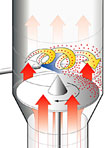|
|
|
 Fluid Bed Pelletizing Fluid Bed Pelletizing
|
|
|
|
|
|
 |
Optimum particles.
Uniformly round with a defined size.
High granulate density.
Due to mechanical forces.
Effective process.
Particle build-up, spheronizing, coating and drying
in one system.
Multifunctional equipment.
For direct pelletizing, coating, solution,
suspension and powder layering.
|
| |
| |
Process advantages
Pellets are manufactured directly and very quickly from a supply of powder
with the addition of a binding agent or solvent. The granules or pellets
produced have a high-density (comparable with granulates from vertical
granulators).
Coatings with a high solid material content can be used, if
required.
When layering, the active ingredient can either
a) be sprayed onto a given
core in a solution of up to 50%,
b) sprayed as a suspension, or
c) dosed
in powder form in conjunction with a solvent and binding agent.
Very thick film layers can be applied by means of the rotor method. The
increase in weight when layering can be up to 10 times the starting weight in
the rotor.
A further advantage is that the tangential nozzle is always
optimally positioned directly in the product.
|
|
|
|
|
Principles of operation
Powder is mixed and moistened in the fluid bed rotor (-> GPCG series with Rotor
Insert). With the fluid bed rotor, solvents or binders are added
tangentially.
The powder bed is set into a centrifugal motion by means of the
rotor. A spiral movement of the powder bed occurs due to the process air, which
is fed through a variable air gap along the edge of the rotor
disc.
Agglomerates are formed, which spheronize into uniform and dense
pellets due to the rotation of the rotor disc (-> Direct Pelletizing, -> Pelletizing by Layering). The speed of rotation
has a direct influence on the density and size of the pellets. The moist pellets
are dried either directly in the rotor during a drying phase with air fed in at
high temperature or in a fluid bed dryer from the WST/G range.
If required, the systems can be made
inert for applications with organic solvents.
(-> Solvent Recovery)
|
|
|
Process Principles
|
|
->Direct Pelletizing
->Pelletizing by Layering
|
|